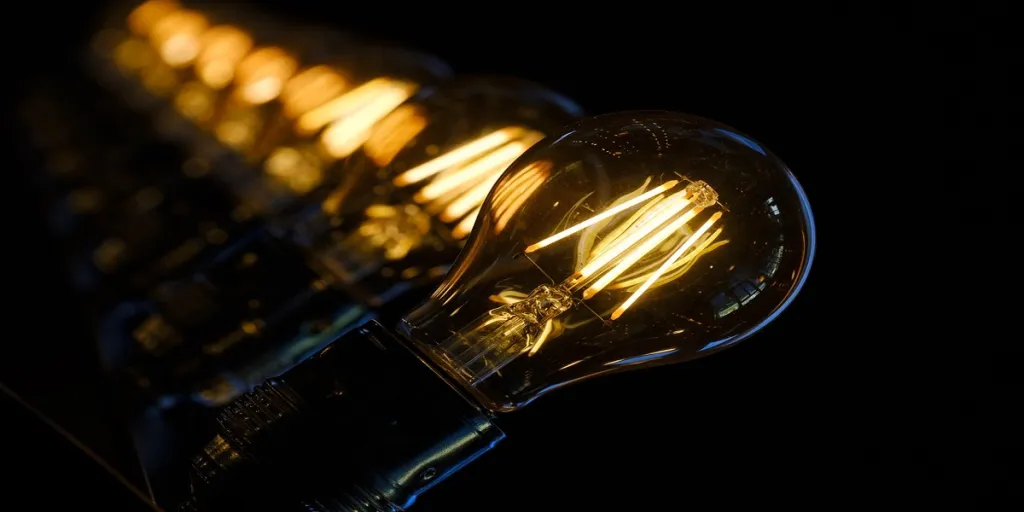In the fast-paced business world, ensuring a safe and conducive environment is vital to better team productivity. And finding the perfect lighting solution for commercial buildings to optimize energy efficiency and cost could be a game changer.
That’s where high bay lights come in.
They help illuminate large business spaces, homes, and outdoor spaces, offering numerous benefits that can enhance commercial operations.
However, selecting the right high bay lights can be a challenge, with many options available on the market.
This buying guide is therefore aimed at making this process easier. So read on to discover the key factors to consider when buying high bay lights, including choosing the right type, and knowing where to install them.
Table of Contents
Benefits of high bay lighting fixtures
Types of high bay lighting fixtures
What to consider when selecting high bay lights
High bay lights: The bottom line
Benefits of high bay lighting fixtures
When it comes to lighting up vast commercial spaces, high bay lights stand out as one of the best solutions. This is because of a number of their key features, including:
Energy efficiency
Every business wants to cut energy costs and improve profitability. And that is where high bay lights take center stage.
Their energy-saving features help businesses reduce their carbon footprint while keeping operational costs in check. In the long term, companies save on energy bills, allocate resources to other critical areas, and improve profitability.
In a case study by Koehler Paper Group, management replaced 164 metal halide lights lamps with LED high bays and reduced the energy needed for the production of 1KG of paper by 20%.
Improved illumination
In business, bright and uniform lighting is not just a matter of aesthetics—it directly impacts productivity and safety.
High bay lights provide high-intensity illumination. This uniformity allows employees to perform their tasks efficiently and safely.
Longevity and durability
Investing in lighting solutions that require frequent maintenance and replacement is costly and time-consuming.
However, high bay lights, like the Waterproof Industrial LED, boast impressive lifespans. They can withstand harsh conditions, including extreme weather and vibrations, thus ensuring long-lasting performance and reduced maintenance needs.
Flexibility in design and control
When it comes to lighting solutions, one size doesn’t fit all.
With a wide range of designs, sizes, and control options, high bay lighting options are suitable for varying spaces. High bay lights are ideal for rooms that need lighting with dimming capabilities, motion sensors, or smart controls.
High bay lights go beyond mere illumination. They are the shining beacons of energy efficiency, productivity, and safety in business spaces.
Types of high bay lighting fixtures
In the quest for the perfect lighting solution, it’s essential to explore the different types of high bay lights available in the market. Here are some notable options:
Metal halide high bay lights

Metal halide high bay lights have been popular in commercial lighting for years. But here’s what you need to know about these lights:
Features
- Powerful illumination capabilities
- High-lumen output, suitable for large spaces
- It has a white light that closely resembles natural daylight
- Good color rendering for enhanced visibility.
Suitable applications and environments
Metal halide high bay lights are well-suited for applications that require high-intensity lighting, such as:
- Large warehouses
- Industrial facilities
- Outdoor sports arenas.
Pros
- Versatile and suitable for various applications
- Quick startup with immediate full brightness
- Appropriate for large spaces requiring ample brightness.
Cons
- Relatively short operational lifespan
- Requires frequent bulb replacements
- Not as energy-efficient as some alternatives
These drawbacks contributed to the invention of LED high bay lights.
LED high bay lights

These high bay ceiling lights are trendy in today’s market. Statistics show that the high bay lighting market was worth US$ 23.41 million in 2021 and is expected to grow at a compound annual growth rate (CAGR) of 8.5% to 2029.
LED technology has revolutionized the lighting industry, providing numerous benefits for commercial spaces.
For instance, LED Ufo Light 100w can enhance employees’ safety in your warehouse or garage.
Features
- Energy efficiency: They consume less energy than conventional lighting options.
- Long lifespan: They have an impressive operational lifespan than conventional lighting sources.
- Instant start: They reach full brightness instantly upon startup, eliminating any warm-up time.
- Directional lighting: LEDs emit light in a specific direction for better control and reduced light wastage.
Suitable applications and environments
You can install LED high bay lights in places like:
- Warehouse ceilings
- Industrial garage spaces
- Manufacturing facilities
- Gymnasiums
- Retail spaces
- Indoor stadiums.
Pros
- LED technology offers significant energy savings and is environmentally friendly
- Their extended lifespan reduces maintenance costs and downtime
- They’re resistant to shock, vibrations, and temperature fluctuations.
- Since LED lights allow customization, one can create the desired ambiance and work environment.
Cons
- High initial cost.
Induction high bay lights

Induction lighting fixtures are popular with commercial and industrial buildings. These lights utilize induction technology to provide efficient and high-quality illumination.
Here are the features, applications, pros, and cons:
Features
- Induction technology that uses a magnetic field to generate light
- High-lumen output
- Wide beam angle
- Durability.
Suitable applications and environments
Induction high bay ceiling lights are suitable for:
- Indoor stadiums
- Exhibition halls
- Warehouses
- Manufacturing facilities.
Pros
- Their high efficiency helps reduce energy consumption and lower electricity costs
- Induction high bay lights have a longer lifespan than traditional lighting options, ranging from 60,000 to 100,000 hours
- These lights generate minimal heat, thus contributing to a comfortable working environment
- They offer improved color rendering properties, which is crucial in industrial applications.
Cons
- Higher upfront costs
- Limited dimming options compared to other lighting technologies
- Finding specific models or replacement parts for induction high bay lights may be challenging
- They’re relatively larger and heavier than other lighting fixtures, thus needing additional support structures during installation.
Fluorescent high bay lighting

Most businesses install these linear high bay lights in garages, industrial spaces, office ceilings, or warehouse ceilings. They utilize fluorescent tubes as the light source and are known for their high lumen output and energy efficiency.
But there are also LED high bay fluorescent lights that act as alternatives to fluorescent tubes. And with a switch, remote, or sensor controls, these lighting options help businesses regulate power consumption, improve safety, and enhance productivity.
Features
- High lumen output
- Energy efficiency
- Color rendering
- Durability.
Suitable applications and environments
- Retail stores
- Offices
- School auditoriums
- Indoor recreational facilities.
Pros
- Fluorescent high bay lights are more affordable than other high bay lighting options
- They are energy efficient and can reduce electricity consumption, resulting in cost savings and lower environmental impact
- Fluorescent tubes have a relatively long lifespan hence reducing frequent replacement and maintenance.
Cons
- Fluorescent lights require a short warm-up period to reach their full brightness
- They contain small amounts of mercury, a hazardous substance.
What to consider when selecting high bay lights

Several factors come into play when deciding on the best lighting fixture. Considering these factors ensure business and home spaces can find a solution that meets their specific lighting requirements.
Lighting intensity and uniformity
Determine the desired light intensity based on the specific application. For example, a warehouse may require higher light intensity than an office space, requiring brighter high bay lighting.
On the other hand, uniform lighting helps minimize shadows and improve visibility, especially in areas for precise tasks, such as assembly lines or manufacturing stations.
Color temperature
How much heat does your business space need from the lighting system? For instance, a warm color temperature like Power CCT Changeable UFO with around 3000K can create a cozy atmosphere in a retail setting. In contrast, cooler color temperature (about 5000K) will suit industrial areas requiring enhanced visibility.
CRI (Color Rendering Index)
A higher CRI value (typically above 80) is ideal for spaces where color accuracy is essential, such as retail stores or art galleries.
Dimming and control options
Businesses and homeowners can assess the availability of high bay light dimming capabilities and compatibility. Dimming allows one to adjust the light output based on the specific requirements of different tasks or times of the day.
Heat dissipation and thermal management
High bay lights generate heat; thus, ensuring the fixtures have effective heat dissipation mechanisms is vital.
Consider features like heat sinks or thermal management systems to help maintain optimal performance and extend the lights’ lifespan. This is particularly valuable if the space experiences high ambient temperatures or requires continuous lighting operation.
Mounting height and beam angle
The lights’ mounting height and beam angles also determine the type of high bay lights. For example, higher mounting heights require narrower beam angles (around 30-60 degrees), while wider beam angles are suitable for lower ceilings, ensuring broader coverage.
Energy efficiency and certification
Look for high bay lights with energy-efficient lighting features, such as LED technology, which provide significant energy savings and have a longer lifespan.
It’s also essential to check for certifications like ENERGY STAR, DLC (DesignLights Consortium), or other energy efficiency labels. These certifications show that the lighting systems are energy efficient and perform better.
Maintenance and serviceability
How easy is it to maintain the lighting system and to find replacement parts? Consider the availability, replacement cost of parts, and the warranty from the manufacturer.
Opt for high bay lights that offer convenient maintenance options to minimize downtime and reduce maintenance expenses in the long run.
High bay lights: The bottom line
High bay lights can revolutionize your business or industrial space, enhancing energy efficiency, productivity, and safety.
But before making a purchase, this guide has aimed to highlight some of the key aspects to consider. On top of this, it’s important to consult experts who can guide you toward a lighting solution tailored to your business requirements.
Remember, choosing high bay lights can elevate your team’s mood, reduce energy costs, and increase profits.
So, invest wisely and embark on a transformative path that will illuminate your operations for years.





 বাংলা
বাংলা Nederlands
Nederlands English
English Français
Français Deutsch
Deutsch हिन्दी
हिन्दी Bahasa Indonesia
Bahasa Indonesia Italiano
Italiano 日本語
日本語 한국어
한국어 Bahasa Melayu
Bahasa Melayu മലയാളം
മലയാളം پښتو
پښتو فارسی
فارسی Polski
Polski Português
Português Русский
Русский Español
Español Kiswahili
Kiswahili ไทย
ไทย Türkçe
Türkçe اردو
اردو Tiếng Việt
Tiếng Việt isiXhosa
isiXhosa Zulu
Zulu